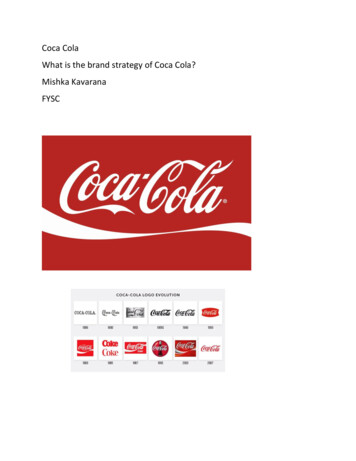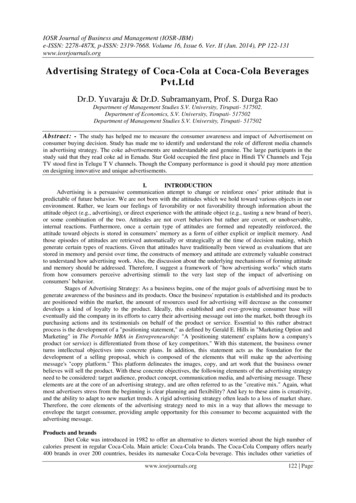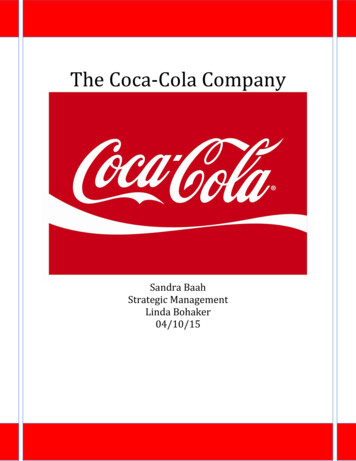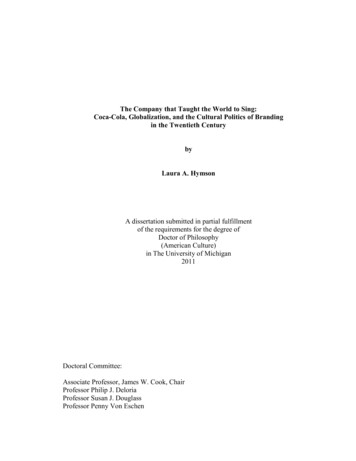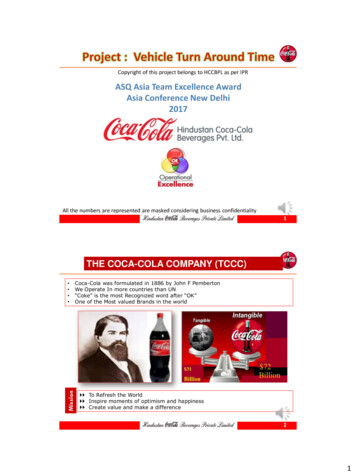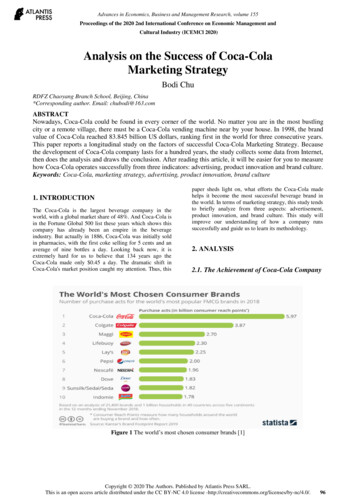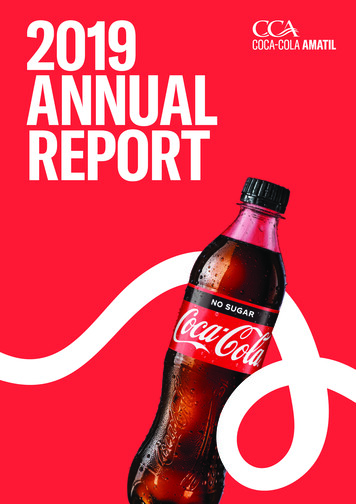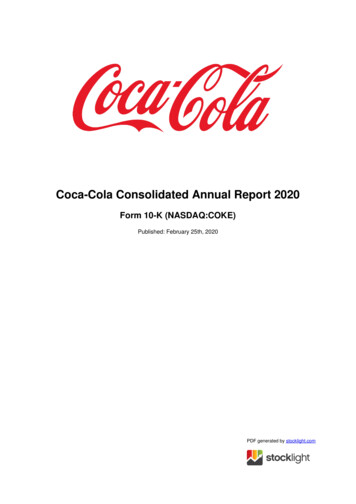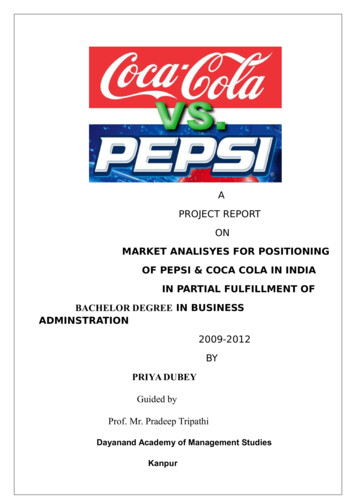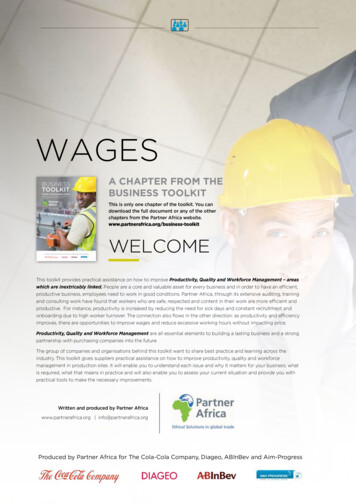
Transcription
WAGESA CHAPTER FROM THEBUSINESS TOOLKITThis is only one chapter of the toolkit. You candownload the full document or any of the otherchapters from the Partner Africa omeThis toolkit provides practical assistance on how to improve Productivity, Quality and Workforce Management – areaswhich are inextricably linked. People are a core and valuable asset for every business and in order to have an efficient,productive business, employees need to work in good conditions. Partner Africa, through its extensive auditing, trainingand consulting work have found that workers who are safe, respected and content in their work are more efficient andproductive. For instance, productivity is increased by reducing the need for sick days and constant recruitment andonboarding due to high worker turnover. The connection also flows in the other direction: as productivity and efficiencyimproves, there are opportunities to improve wages and reduce excessive working hours without impacting price.Productivity, Quality and Workforce Management are all essential elements to building a lasting business and a strongpartnership with purchasing companies into the future.The group of companies and organisations behind this toolkit want to share best practice and learning across theindustry. This toolkit gives suppliers practical assistance on how to improve productivity, quality and workforcemanagement in production sites. It will enable you to understand each issue and why it matters for your business, whatis required, what that means in practice and will also enable you to assess your current situation and provide you withpractical tools to make the necessary improvements.Written and produced by Partner Africawww.partnerafrica.org info@partnerafrica.orgProduced by Partner Africa for The Cola-Cola Company, Diageo, ABInBev and Aim-Progress
The BusinessToolkit Contents1.Productivity and efficiency82. Quality343. Health & safety – a platform for productivity484. Time management and productivity565. Worker Cooperation and Communication665.1OVERVIEW5.2 Freedom of Association725.3 Grievance procedure75 6. Workforce Management 66786.1 Wages806.2 CHILD LABOUR AND YOUNG WORKERS836.3 Forced labour866.4 Discrimination/harassment886.5 Regular employment927. Environment968. Business integrity1009. Land rights104DisclaimerThe information provided is intended forgeneral guidance and information purposesonly. Opinions expressed in this documentdo not constitute professional adviceand shall not give rise to any legal claims,rights, obligations or liabilities against theorganisations involved in this document. Itis the responsibility of the user to ensuresuitable measures are taken to ensureall legal requirements are met and anyimprovements are suitable for the relevantoperation. The organisations involved in thisdocument will not be liable for any misuseand do not assume any responsibility forerrors and omissions in the contents. Whereexternal sources are quoted or referenced,the organisations involved in this documentdo not guarantee the accuracy, relevance,timeliness, or completeness of anyinformation in these external sources. In noevent shall the organisations involved inthis document be liable for damages of anykind including any special, direct, indirect,consequential, or incidental damages,whether in an action of contract, negligenceor other tort, arising out of or in connectionwith the use of the information provided.The content of this Toolkit was developedby Partner Africa and consultants, inconjunction with the participating brands.Each company may have additional and/or specific requirements on the topicscovered in this document and thus thisToolkit should be utilised as a referenceguidance only.
6. WorkforcemanagementWhy this is important to your businessWorkforce management (also called Human Resources Management or HRM) means the way that people are managedwithin the business. It is not something that happens in one department but it is everyone’s responsibility to ensuregood practices and relationships are developed.The benefitsThe cost of employee turnoverIn many cases, the biggest competitive advantage a business hasis the knowledge, skills, competence, motivation and productivityof its workforce. Businesses need to have the right practicesand systems in place, in order to actualise and really capitaliseon the full potential of the talents and value of the workforce. Ifgood workforce management succeeds in increasing workers’motivation and commitment, there are significant benefitsto the business, including lower turnover, higher skill retention,lower recruitment costs, higher productivity and the attractionof skilled and experienced workers (as illustrated in many of thebusiness benefits flow diagrams in this toolkit).If you have good relations with your workers andmanage them well, they will be less likely to be absentand leave. The true costs of employee turnover are oftenunderestimated. The total of the direct and indirectcosts are estimated to be between 30% and 150% ofthe employee’s remuneration package (for entry andmid level employees). Direct costs include managementtime and other costs of recruiting and training new staffand indirect costs include lost productivity, reducedperformance levels and unnecessary overtime premiumsrelated to new staff being less skilled 64.It is a valuable exercise to calculate the employeeturnover costs to your business, to understand thecost benefits of better engagement and treatment ofworkers. A practical tool is provided for you to do that inAppendix 1 (page 108).WHOWho needs to be informed and involved in tacklingthese issues?Senior management, HR managers, production manager,supervisors, payroll staff, those involved with recruitingpermanent and temporary staff.General practical tools and tipsThe cycle of Human Resource ManagementThis is a useful tool for planning and maintainingHuman Resources Management, while keepingthe big picture in mind. Every element of HRMwill fit into one aspect of this cycle: Recruitment,Staff motivation (includingremuneration and conditions ofemployment), Staff developmentand performance (includingtraining and performancemanagement), Separation ortransfer (including dismissal).RECRUITMENTseperation& transferHRSTRATEGYDEVELOPEMENTThe Lifecycle of the HumanResources Strategy 65& PERFORMANCE78STAFFMOTIVATIOn
Staff motivationA key part of this cycle is ‘staff motivation’. A valuableconcept in thinking about staff motivation is Maslow’shierarchy of needs 65.5. Maslow’s theory suggests that thelower or basic needs (safety and security) have to besatisfied before the higher order needs (self-esteem andachieving potential) become a concern to the individual. Itsuggests that employees will only be motivated to improveproductivity and grow in their skills and abilities, if the lowerlevel needs are met first.Internal and external factorsEvery business is impacted by both internal and externalfactors. These impact how it functions and how it managesits workforce. Internal factors include: strategic businessobjectives, organisational structure, enterprise culture/policies and labour relations. External factors include:economic context, industry policy, activity of competitors,requirements of customers, national laws and regulations,international labour standards, demography and laboursupply issues.There are a number of factors that can be drawn out fromthis diagram, that impact the motivation of employeesat work, some of which are dealt with in this ‘WorkforceManagement’ chapter and others are dealt with in otherchapters. Basic biological and physiological needs met: wages andbenefits Feeling safe and secure: health and safety, not workingexcessive hours, job security/regular employment, aculture of respect – with no discrimination or harassment Belonging: Teamwork Self-actualization: Training, opportunities for promotionA key aspect of the external factors impacting how abusiness runs is the national laws and regulations it mustadhere to in order to have licence to operate in the country.These legal requirements have a significant impact onworkforce management and set certain minimum standardsfor a number of issues. Some of these issues/topics arecovered in other sections of this toolkit but many of the keyelements of legal requirements for workforce managementare covered in this chapter: wages/benefits, discriminationand harassment, child labour, forced labour and regularemployment.Feeling valued: Teamwork, regular feedback andappraisals, able to contribute ideas for improvements,grievance mechanismmaslow’s hierarchy of needswhat this means in the work placeself-actualization / self-fulfilmentAchieving one’s potentialEsteem needsSelf-esteem, the respect of others, recognitionDeveloping within their jobs, improving abilities,learning new skills, increasing productivityFeeling valued for what they do, given responsibilityand rewarded for what they do wellsocial needsAcceptance, work group, the need to be loved, to feel wantedBelonging to a team andcontributing positivelysafety needsFeeling safe in the workplace and in life(H&S, discrimination, harassment, hours)biological and physiological needsHave enough money to provide forbasic needs of family (wages and benefits)79
6.1 Wages and benefitsWhy this is importantto your businessvalue to businessWAGESreducedstaff turnoverPayingdecentwagesIncreased jobsatisfaction,workermorale andloyaltylowerabsenteeismimprovedproductivity edreputationBETTERNUTRITION /WELLNESSSTRONGER MORERESILIENT WORKERS /fewer health issuesReduced businesscosts ofrecruitmentand trainingReduced businesscosts of loss ofproductionImprovedprofitabilityReduced costof recruitmentCost benefitof high qualitystaffReduced lostproduction dueto sicknessThe connections illustrated in this diagram have been evidenced by various studies reported in Forbes Magazine and HarvardBusiness Review. 68CasestudyUS retailer Costo has decided itmakes business sense to give goodwages, benefits and training andin turn it has significantly higherretention and performancelevels, which saves significantcosts of employee turnover(recruitment and training). 66The company’s more stable and productiveworkforce has been shown to more than offsetthe costs. Costco has a employee turnover of 17%overall (just 6% after one year’s employment)compared to 44% at Walmart, close to the industryaverage. 67The Expectations Pay wages according to at least the legal minimum standards or appropriate industry standards, whichever is higher.Provide the legally required benefits to all workersBest practice: Beyond this, suppliers should work towards providing workers with a pay and benefits package thatsupports an adequate standard of living (‘living wage’/ ‘fair wage’) c80
What ThIS MEANS IN PRACTICEThis section explains the details of what this means in practice and can also beused as a tool to self-assess your site.Put aif you think that point is in place in your business and put aif it isn’t or needsimprovement. You can then create an action plan, to assign and follow up an action for every(sample action plans are given at the back of the toolkit).ooKnow what the legal minimum wage is for your country, your industry as well as employmentcategories within your businessooKnow what the legal requirements are regarding benefitsooAll workers’ wages meet or exceed the legal minimum wage or industry benchmark standards,whichever is higher (before overtime premiums and bonuses).cooWages are paid directly to the worker by the employer (for example the employer may be thesupplier or a sub-contractor to the supplier)ooDeductions and fines are all legal and not excessive (including for food, housing, transport andutilities)ooDeductions from wages as a disciplinary measure is not allowedooPayslips are provided indicating hours, overtime premiums, pay (piece rate if applicable), bonusesand any deductionsooWage and payment details are communicated to workers in written and understandable format,before entering employment and for each pay periodooAll legal benefits are given to workers (eg holiday and sick pay). This includes developing a systemfor workers to request and have holiday approved and a clear procedure for taking a sick day. This isclearly communicated to workersooIf local law requires it, employers and employees participate in social benefits and social insurancepremium payments, paid in full at the required timeooRecords are kept for at least 12 months including pay journal/payroll, timecards, production records,piece rate records for all workerscIn some cases you may be paying the legal minimum wage but workers still do not seem to be able to live on that salary and support their families. In many countries,production site workers are supporting up to 10 dependents on their salary. The ideal is for your business to work towards what is called a ‘Living Wage’, which enablesa family to meet their basic needs and some discretionary income. Social Accountability International breaks down “basic needs” into: “a standard level of nutrition,housing, transportation, energy, healthcare, childcare, education and savings within regulated working hours (eg without overtime hours).” For more information: BaseCode Guidance: Living wages. Ethical Trading Initiative idance-living-wages81
Practical tipsTACKLING TOUGHSITUATIONSAs you increase productivity and efficiencyof your production unit, it may be possible toincrease wages for workers, beyond the minimumlegal wages and ideally to move towards ensuringthey can meet their basic needs on their wage.This progress will benefit the company byreducing the costs of employee turnover, sicknessand dissatisfaction and attract better skilledworkers.What dO you noticeThere is adifference in yourworkplace between whatmen and wo
Resources Strategy 65 The benefits in many cases, the biggest competitive advantage a business has is the knowledge, skills, competence, motivation and productivity of its workforce. Businesses need to have the right practices and systems in place, in order to actualise and really capitalise
